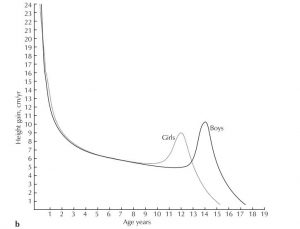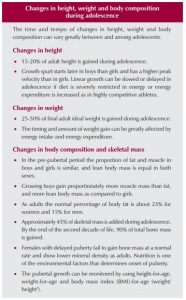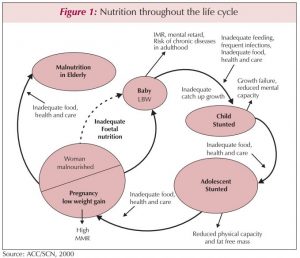
Table of Contents
Who are Adolescents?
- Adolescents are any person between the age group of 10- 19 years
- Adolescence is the time period when an individual undergoes physical, mental and emotional changes
- It is the fastest growing period after infancy, and thus, nutrition is necessary for the proper growth and development.
- Nutrition for adolescent refers to the act of ensuring adequate nutrition to the adolescents required for their proper health, growth and development and also to prevent them from diseases.
- This period is also known as the ‘Second Window of Opportunity’
Rationale for Focusing on Adolescent Nutrition:
- Large percentage of adolescents are suffering from nutritional deficiencies.
- Adolescents are often the neglected population group.
- The nutrition program is either focused on pregnant women or child but rarely on the adolescents.
- Around 1.2 billion people, or 1 in 6 of the world’s population, are adolescents age 10 to 19 years
- Nearly, 35% of the global burden of disease has its root in adolescence.
- However, researches regarding stunting and wasting among the adolescents are relatively less compared to other age group
- Inadequate nutrition places an adolescent in the risk of chronic disease. Globally, the prevalence of obesity (BMI >2 S.D BMI-for-age z score) has risen from <1% in 1975 to more than 5% in girls and nearly 8% in boys age 5–19 years in 2016.
- Good nutrition and nutritional habits at this period of time determines the overall heath pattern of a nation
Why is Adolescence a Nutritionally Critically Important Period of Life?
- This phase of life experiences sharp increase in physical growth and development. During this period, adolescents will experience a weight gain equivalent to 65% of their weight at the beginning of the period and 40% of their final weight, and a height gain equivalent to 15% of their adult height (Brasel, 1982)
- Food habits and food style changes drastically during this period which may have longer term impact in health and life
- Increased nutritional demand due to sharp physical and mental growth
- It is the second-best window of opportunity to catch up with proper growth and development, if provided with adequate nutrition.
Velocity curve for height in boys and girls, from birth to 18 years

Importance of Adolescent Nutrition in Life Cycle Approach:
- Adolescent health is one of the most important stages in the life cycle approach.
- The health status and the behavior at this stage determines the health in coming days.
- Adolescent is an important linkage in life cycle approach.
- Adolescent health represents the health status of child and determines the health of adult
- Health intervention at such age is sustainable, suitable and effective.
- Proper care and attention need to be given.
- Proper nutrition is necessary for the overall growth of individual, develop the immunity and also to rule out the occurrence of chronic disease in future which often have roots in this period
- Proper intervention at adolescent period is also necessary to intervene the poverty cycle
Globally Implemented Interventions to Strengthen Adolescent Nutrition:
- Nutrition counselling is one of the common interventions for adolescent nutrition.
- Countries like Guatemala, Kenya, Bangladesh, Nepal, etc., has adopted this intervention along with the provision of iron and folic acid supplementation to the adolescent girls.
- Deworming in schools and foods fortification are the common intervention carried out worldwide.
- In France, Ireland, UK and Spain, food fortification, and particularly of breakfast cereals, has positively contributed to increasing vitamin and mineral intakes in childhood and adolescence.
a) SABALA
The program was initiated in India with the aim of improving the nutritional status of adolescent along with their empowerment and provision of reproductive and sexual health services. It comprises of nutrition and non-nutrition as its major components. The scheme targets the adolescent girls of the age group 11-18 years. Girls need to visit these centers twice a month during school times and more on the vacation. The center would provide the following nutrition related services:
- Nutrition provision
- Iron and Folic Acid (IFA) supplementation
- Health check-up and Referral services
- Nutrition & Health Education (NHE)
- Others
By the end of 2011, it had been rolled out in 13 states, reaching 27.6 million adolescent girls (16.3 million school-going, 11.3 million out of school). This program reported good results in terms of adherence (>85%) and reduction in the prevalence of anemia.
b) The right start initiative
The “Right Start Initiative” is an initiative to reach over 100 million women and girls with improved nutrition. It is a micro-nutrient initiative. Nutritional International (NI) has started ‘Right start initiative’ with the vision to end malnutrition and to transform the life of vulnerable people especially women, adolescent girls and children by the improvement in their nutritional status. The initiative has started mostly in Africa and Asia and few American countries.
‘Right start initiative’ focuses on:
- Research and policy
- Women and girls’ nutrition
- Infant and young child health
- Salt iodization
- Supplementation
- Fortification
Recommendations to improve adolescent nutrition:
- Supportive policies based on human rights principles. These policies need to be integrated into national health policies.
- All the interventions need to be both youth sensitive and gender sensitive
- Multi-sectoral approach is necessary. Related departments and agencies need to work in the given sector.
- Knowledge regarding adolescent nutrition should also be included in the curriculum
- Establishing or starting adolescent friendly health and nutrition centers to tackle with the special needs and problems of adolescent nutrition
- Social Behavior Change Communication (SBCC) focusing on adolescent nutrition
- Food based strategies like dietary diversification and food fortification targeting the adolescents
- Regular nutritional assessment and counselling to the adolescents
- Conduct more researches on adolescent health
- Direct interventions by food fortification (if necessary) and food supplement
References and for More Information:
http://www.who.int/nutrition/publications/schoolagechildren/SEA_NUT_163/en/
https://www.ncbi.nlm.nih.gov/pubmed/11255499
https://www.nutritionintl.org/about/
http://apps.searo.who.int/pds_docs/B0239.pdf
https://www.ncbi.nlm.nih.gov/pubmed/10036686
http://apps.searo.who.int/pds_docs/B0239.pdf
http://www.who.int/en/news-room/fact-sheets/detail/adolescents-health-risks-and-solutions
NCD Risk Factor Collaboration (NCD-RisC): Worldwide trends in body-mass index, underweight, overweight, and obesity from 1975 to 2016: a pooled analysis of 2416 population-based measurement studies in 128.9 million children, adolescents, and adults. Lancet 2017; 390: 2627–2642.
https://www.karger.com/Article/FullText/488865#ref8
http://www.euro.who.int/__data/assets/pdf_file/0019/140671/CorpBrochure_lifecourse_approach.pdf
https://reliefweb.int/sites/reliefweb.int/files/resources/Adolescent_Nutrition.pdf
http://wcd.nic.in/sites/default/files/1-SABLAscheme_0.pdf


